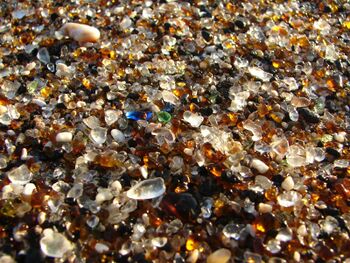Sea glass: Difference between revisions
Jump to navigation
Jump to search

imported>Joe Quick (stub for fun) |
imported>Joe Quick mNo edit summary |
||
| Line 1: | Line 1: | ||
{{subpages}} | {{subpages}}[[Image:Sea glass.jpg|right|thumb|350px|{{#ifexist:Template:Sea glass.jpg/credit|{{Sea glass.jpg/credit}}<br/>|}}An unusual amount of sea glass for a single beach.]] | ||
'''Sea glass''' is formed when broken pieces of glass from bottles, tableware, and other items that have been lost or discarded are worn down and rounded by tumbling in the waves along the shore of oceans and large lakes. The most common varieties are green, brown or clear, while other colors, such as orange, red, yellow, cobalt blue, purple, turquoise, and black are much more rare in genuine sea glass.<ref>North American Sea Glass Association. [http://seaglassassociation.org/GenuineVsArtificial.php "Genuine vs. Artificial"] Electronic document, retrieved June 25, 2008.</ref> Genuine sea glass often shows signs of "hydration", a process by which the soda and lime in the glass are slowly leached out through constant contact with water, and may be easily distinguished from artificially tumbled glass by a trained eye. | '''Sea glass''' is formed when broken pieces of glass from bottles, tableware, and other items that have been lost or discarded are worn down and rounded by tumbling in the waves along the shore of oceans and large lakes. The most common varieties are green, brown or clear, while other colors, such as orange, red, yellow, cobalt blue, purple, turquoise, and black are much more rare in genuine sea glass.<ref>North American Sea Glass Association. [http://seaglassassociation.org/GenuineVsArtificial.php "Genuine vs. Artificial"] Electronic document, retrieved June 25, 2008.</ref> Genuine sea glass often shows signs of "hydration", a process by which the soda and lime in the glass are slowly leached out through constant contact with water, and may be easily distinguished from artificially tumbled glass by a trained eye. | ||
Revision as of 10:36, 25 June 2008
Sea glass is formed when broken pieces of glass from bottles, tableware, and other items that have been lost or discarded are worn down and rounded by tumbling in the waves along the shore of oceans and large lakes. The most common varieties are green, brown or clear, while other colors, such as orange, red, yellow, cobalt blue, purple, turquoise, and black are much more rare in genuine sea glass.[1] Genuine sea glass often shows signs of "hydration", a process by which the soda and lime in the glass are slowly leached out through constant contact with water, and may be easily distinguished from artificially tumbled glass by a trained eye.
- ↑ North American Sea Glass Association. "Genuine vs. Artificial" Electronic document, retrieved June 25, 2008.
